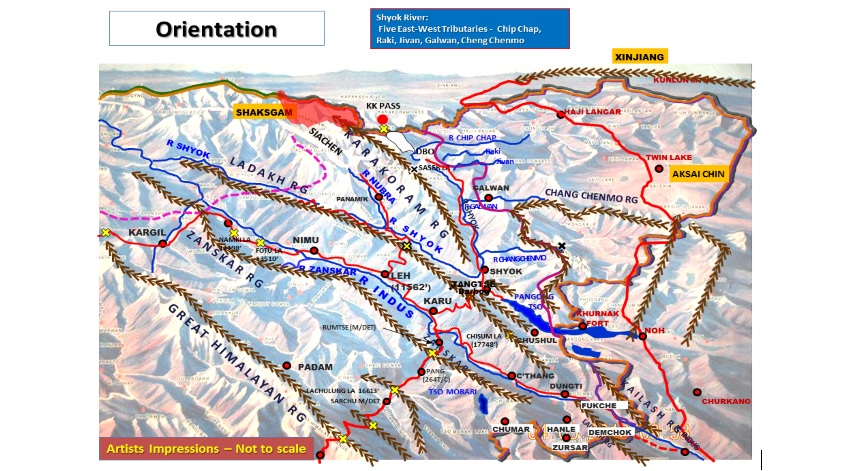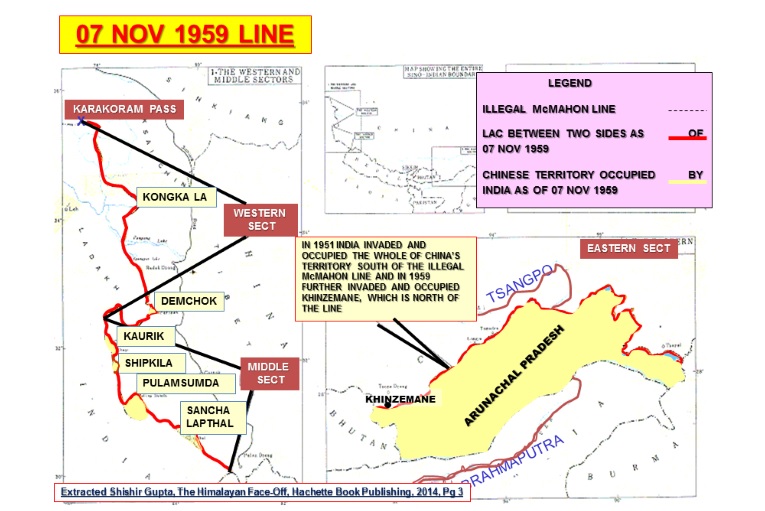On 16 April 2013, ITBP discovered a new Chinese six tent position near Raki Nullah in the Sub Sector North of Eastern Ladakh. On 18 April, when the Indian Army asked PLA to withdraw to its original positions, the PLA produced a map which was part of the annexure to a letter written by Zhou (Premier Chou en Lai) to (PM) Nehru, to buttress its case... an indicator that the PLA had come prepared. As the laid down protocol of military disengagement did not succeed, a face-off began, that lasted almost three weeks, five high decibel border flag meetings. A significant step was taken by the Indian Army under the guidance of the Northern Army Commander, some 500 km away from Depsang. The Indian Army constructed a tin shed to a point known as 30 R in Chumar. On the 23 April, the PLA tried to strike a deal with the Indian Army by linking from the Depsang plains to...removing the tin shed in Chumar (30R). On 05 May both sides disengaged from Depsang plains and the Indian troops returned to their old position in Chumar after dismantling the 30 R tin shed.1 The event narrated is significant in the light of the recent transgressions on the Line of Actual Control since 05 May 2020, that have not been fully resolved even after a series of Border Personnel Meetings – including the one led by the 14 Corps Commander, as a first, on 06 June 2020.

At this juncture it is relevant to flash back to the letter written by Premier Chou en Lai dated 07 Nov 1959, which postulated ‘...each side withdraw 20 kilometres ... from the line up to which each side exercises actual control in the west (Ladakh). Shivshankar Menon has explained in his book ‘Choices: Inside the Making of India’s Foreign Policy’ that the LAC was “described only in general terms on maps not to scale” by the Chinese. Zhou (Chou en Lai) clarified the LAC again after the war in another letter to Nehru: “To put it concretely ... in the western and middle sectors it coincides in the main with the traditional customary line which has consistently been pointed out by China”.
During the Doklam crisis in 2017, the Chinese Foreign Ministry spokesperson urged India to abide by the “1959 LAC”.2 Shyam Saran has disclosed in his book ‘How India Sees the World’ that ...India formally accepted the concept of the LAC when (PM) Rao paid a return visit to Beijing in 1993 and the two sides signed the Agreement to Maintain Peace and Tranquillity at the LAC. The reference to the LAC was unqualified to make it clear that it was not referring to the LAC of 1959 or 1962 but to the LAC at the time when the agreement was signed. 3 The sketch shown herein clearly indicates that Chinese reference to ‘1959 LAC’ deliberately muddies the waters, understanding fully that it cannot be translated to map and ground especially in Eastern Ladakh. It can only be done physically, as was done on the delineation of Line of Control with Pakistan in 1972.

India and China have been negotiating on the boundary question for long through a number of mechanisms. Though talks had commenced in 1981, Joint Working Group (JWG) was established in 1988, for ensuring peace and tranquillity in the border areas and making recommendations for an overall solution to the boundary question India and China agreed to Confidence Building Measures (CBMs) through bilateral agreements signed in 1993, 1996, 2005, 2012 and 2013. The Special Representatives (SR) mechanism was established in 2003 to explore from the political purpose of the overall bilateral relations in the framework of a boundary settlement. Both JWG and SR are exclusive mechanisms. April 2005 Agreement referred to a package settlement (as against a sector-by-sector approach previously).
It has been nearly six decades since the 1959 letter and 1962 War, and three decades since negotiations began, but the issues remain unresolved. Over time the Chinese developed intensive infrastructure, especially metalled roads right up to their perception of LAC. In the last twenty years, India too has undertaken immense strides in developing infrastructure despite the fact that Ladakh remains cut off for six months a year. New Cantonments with complete eco-system have been developed in Tangste-Darbog (near the Pangong Tso) and Nyoma. The axial and laterals roads in Eastern Ladakh, have been extensively developed. Over the last decade and a half, the Darbog-Shyok Daulat Beg Oldie (DS-DBO) road had been extensively used for sustenance of forces in Sub Sector North in the winter season when the River Shyok was frozen. This got an immense fillip and with the inauguration of Bridge on the River in August 2019.
The current situation in Eastern Ladakh needs deliberation. “Transgressions” which occur with regularity are mutually and amicably resolved, even without reaching the media, under the provisions of the various agreements by CBMs like the ‘banner drills’ or ‘Border Personnel Meetings’ (BPM). However, in the last decade, there has been a distinctly a high level of belligerence by the PLA as outlined below:
- The ‘face-offs’ for nearly a decade have transcended to a higher plane, that does not lead to disengagement for a very long time, fisticuffs, brawls, use of batons and finally firming in an adversarial atmosphere for a long time. The incident at Raki Nullah in April 2013, mentioned above, showed a failure of CBMs, as disengagement did not take place. Subsequently Chumar, Pangong Tso, Demchok, Hot Springs and recently Galwan River, have witnessed such events annually. Solace cannot be drawn from the fact that none of these incidents have led to firing due to immense self control and discipline. Events have a life of their own and that the following ones will not spiral out of control and create an international incident, and even limited escalation, cannot be guaranteed.
- India’s development of roads to the border posts has been progressing. However, the stage has now reached to create ‘last mile connectivity’ to the LAC, at places linking up with that created by the Chinese. This invariably results in a violent response from the Chinese and prolonged face-offs. It is likely that the current face-off at Galwan River and Pangong Tso are results of similar creation of feeder tracks. This advantage that the Chinese possess gets translated into denial of patrolling by our units to our LAC, by executing a deliberate face-off, utilising their road network. Case in point is Pangong Tso, where, while tasked to move to Finger 8 (own LAC), and as movement from the track on the rock face from Finger 3 to 4 takes time, PLA is able to move by vehicles from Sirijap and deny progress at Finger 4/5 itself. This invariably leads to a brawl at that area. It is utterly inexplicable and illogical that while the Chinese have developed infrastructure till the tail end of their perception of LAC, they resort to violence in denying the same to us. On the one hand, the Chinese refuse to move forward on delineation processes, and on the other they prevent our patrols to touch-base at our designated patrol points.
- The established CBMs, the protocols and the architecture to avoid physical contact of PLA and own units, and the BPM mechanism to disengage or resolve issues, is gradually failing, or is at its seams. Though positive benefits of discussions at the BPMs are undeniable, if their outcomes do not immediately translate into disengagement, and the face-off gets prolonged, there could be frayed nerves.
As has been argued above, the Chinese are intransigent on commencing a delineation process, on allowing last mile connectivity to us to our LAC, denying patrolling to the same (which leads to physical clashes) and tangible progress in BPMs. It is becoming convenient to ascribe motivation of the Chinese to external pressures, the apparent internal anxieties due to the COVID-19 situation, the enhanced levels of aggression it has shown against some of the nations on its periphery, or any reaction to abrogation of Article 370/ own references to Aksai Chin. All of these did not exist in the last eight years, when such aggression from PLA was similarly evident.
In fact, it only seems to confirm the apprehension that the recent events at Galwan, Pangong Tso and Hot Springs were certainly not localised, and with the one at Naku La, were orchestrated from the apex, maybe even the CMC. This places own forces in a serious quandary that mandates that status quo should not be allowed to persist interminably! Four issues need resolution soonest. First is the disengagement of forces from ongoing face-offs, to the locations pre 05 May 2020. This must be achievable without any give or take. Second, is the assurance that own patrols will be able to move to the designated areas, as hitherto fore, without deliberate blocking by PLA. As to reach the farthest end of own LAC is an imperative, a schedule can be arrived at with the PLA that does not lead to contestation. Third, is to intimate that we WILL undertake the last-mile connectivity to facilitate our management of the LAC, something that PLA has already largely completed. And lastly, and most importantly, re-examine the protocols and the laid down architecture of CBMs. This is to ensure that the next such event does not spiral out of control.
Let it be stated herein, that the trend of events indicates that prolonged face-offs may be the new normal. Galwan and Pangong Tso, in this context are important, but harbingers of what may follow. As this article goes to press, there are positive indicators through media reports that disengagement and withdrawal of forces had been agreed to in Galwan Valley and the area of Hot Springs, as a consequence of the BPM held on 06 June 2020. On Pangong Tso, however, further consideration will be required. A holistic addressal of the issues above should be included in future deliberations between the two militaries to obviate recurrences.
Without undue bravado and boast, let it be dispelled that Indian Armed Forces in Eastern Ladakh and along the LAC, in the 21st century, are any pushover in conventional conflict or even a skirmish, whatever be the force asymmetry. Or that Chinese designs in Gilgit-Baltistan and in Eastern Ladakh can be co-terminus! Exactly to the contrary! On inflexible face-offs that are most likely, the April 2013 event mentioned above and the September 2014 response at Chumar must become copy-book for Army’s planned methodology of strategising-tactics hereinafter. Such opportunities are galore, and can easily turn the tables. Contingent on the fallout of the BPM held on 06 June 2020, opportunities can even be created at this juncture, to force a serious consideration to the PLA!
It may be however necessary for the Army to consider acquisition of ‘sunrise’ capabilities of the LAC, a subject for discussion separately. It is imperative also to examine at the Apex, the optimal force levels for the LAC, as the move of contingency forces from plains is counter-productive in their timeliness in location and the apprehension that it creates in public opinion. The Government-Armed Forces must also evolve a dynamic information dissemination policy; otherwise, know-all ‘experts’ take advantage of the vacuum and with total inaccuracies, cause grave consternation within the armed forces, and the nation at large.
Discipline of the Indian Armed Forces, in warfare or in skirmishes is a virtue, but it must not be confused with being ‘meek’; it is a sign of strength, awaiting release at the opportune moment!
End Notes
- Excerpts extracted from Shishir Gupta, The Himalyan Face-Off, Chinese Assertion and the Indian Riposte, Hachette Book Publishing India Pvt Ltd, Gurgaon, 2014, p1-7.
- Sushant Singh, Line of Actual Control: Where it is located, and where India and China differ
The Indian Express 02 Jun 2020 - Ibid
(The paper is the author’s individual scholastic articulation. The author certifies that the article/paper is original in content, unpublished and it has not been submitted for publication/web upload elsewhere, and that the facts and figures quoted are duly referenced, as needed, and are believed to be correct). (The paper does not necessarily represent the organisational stance... More >>











Post new comment